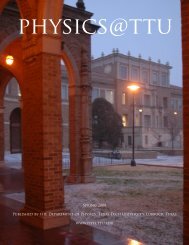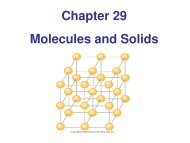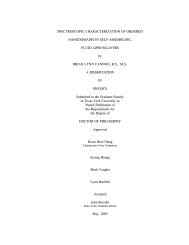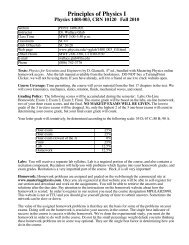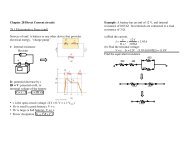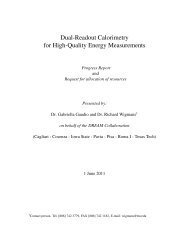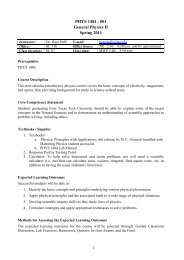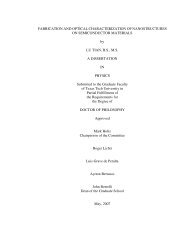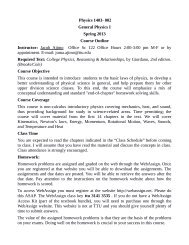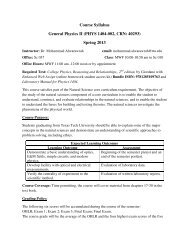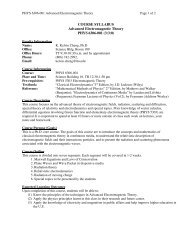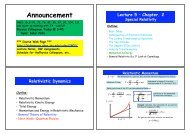Version One â Homework 1 â Juyang Huang â 24018 â Jan 16 ...
Version One â Homework 1 â Juyang Huang â 24018 â Jan 16 ...
Version One â Homework 1 â Juyang Huang â 24018 â Jan 16 ...
Create successful ePaper yourself
Turn your PDF publications into a flip-book with our unique Google optimized e-Paper software.
<strong>Version</strong> <strong>One</strong> – <strong>Homework</strong> 1 – <strong>Juyang</strong> <strong>Huang</strong> – <strong>24018</strong> – <strong>Jan</strong> <strong>16</strong>, 2008 14<br />
y<br />
a<br />
E<br />
× (0.133632 N m 2 /C)<br />
= 1.1832 × 10 −12 C .<br />
z<br />
c<br />
What is the magnitude of the net charge<br />
enclosed by the surface<br />
Correct answer: 1.1832 × 10 −12 C.<br />
Explanation:<br />
Let : a = b = 0.4 m ,<br />
c = 0.36 m ,<br />
α = 3 N/C , and<br />
β = 2 N/(C m 2 ) .<br />
The electric field throughout the region is<br />
directed along the x-axis and the direction of<br />
d A ⃗ is perpendicular to its surface. Therefore,<br />
⃗E is parallel to d A ⃗ over the four faces of<br />
the surface which are perpendicular to the<br />
yz plane, and E ⃗ is perpendicular to d A ⃗ over<br />
the two faces which are parallel to the yz<br />
plane. That is, only the left and right sides<br />
of the right rectangular parallel piped which<br />
encloses the charge will contribute to the flux.<br />
The net electric flux through the cube is<br />
∫<br />
∫<br />
∆Φ = E x d A ⊥ − E x d A ⊥<br />
right side<br />
b<br />
a<br />
left side<br />
= a b [ α + β(a + c) 2 − α − β a 2]<br />
= a b β (2 a c + c 2 )<br />
= a b c β (2 a + c)<br />
= (0.4 m) (0.4 m) (0.36 m)<br />
× [2 N/(C m 2 )] [2 (0.4 m) + 0.36 m]<br />
= 0.133632 N m 2 /C ,<br />
so the enclosed charge is<br />
q = ɛ 0 ∆Φ<br />
= [8.85419 × 10 −12 C 2 /(N m 2 )]<br />
x<br />
030 (part 2 of 2) 10 points<br />
What is the sign of the charge enclosed in the<br />
surface<br />
1. positive correct<br />
2. negative<br />
3. Cannot be determined<br />
Explanation:<br />
Since there is more flux coming out of the<br />
surface than going into the surface, the sign<br />
of the enclosed charge must be positive.<br />
Flux Through a Loop 01<br />
24:01, calculus, numeric, > 1 min, normal.<br />
031 (part 1 of 1) 10 points<br />
A 40 cm diameter loop is rotated in a uniform<br />
electric field until the position of maximum<br />
electric flux is found. The flux in this position<br />
is measured to be 520000 N · m 2 /C.<br />
What is the electric field strength<br />
Correct answer: 4.13803 × 10 6 N/C.<br />
Explanation:<br />
Let : r = 20 cm = 0.2 m and<br />
By Gauss’ law,<br />
∮<br />
Φ =<br />
Φ = 520000 N · m 2 /C .<br />
⃗E · d ⃗ A<br />
The position of maximum electric flux will be<br />
that position in which the plane of the loop is<br />
perpendicular to the electric field; i.e., when<br />
⃗E · d ⃗ A = E dA. Since the field is constant,<br />
E =<br />
Φ = E A = Eπ r 2<br />
Φ<br />
π r 2<br />
= 520000 N · m2 /C<br />
π (0.2 m) 2<br />
= 4.13803 × 10 6 N/C .



